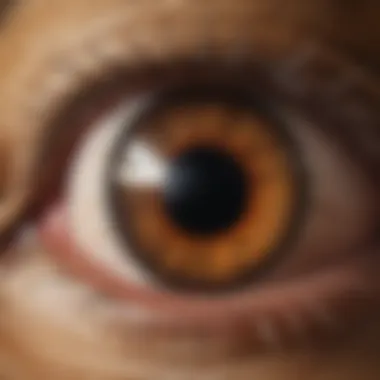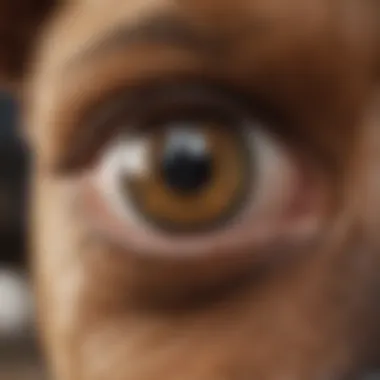Understanding Eye Disease in Dogs: A Comprehensive Overview


Intro
Eye disease in dogs is a subject that warrants keen attention not only from pet owners but also from veterinarians and animal healthcare professionals. Understanding the various conditions that can afflict a dog's eyes is imperative for timely diagnosis and effective treatment. This guide aims to break down complex information into digestible segments, presenting details on different types of eye diseases, their causes and symptoms, as well as diagnostic and treatment options.
Canine ocular health is often overlooked. However, the eyes are as vulnerable to diseases as any other organ in the body. Recognizing the signs early can make a significant difference. This comprehensive overview explores these crucial aspects in detail, promoting awareness and understanding.
Key Findings
Summary of the Main Results
Conducting thorough research, this guide emphasizes critical aspects of canine eye diseases. It categorizes diseases into various types, such as cataracts, glaucoma, progressive retinal atrophy, and cherry eye. Each condition has distinctive signs and underlying causes, requiring different approaches to treatment. Symptoms often include cloudiness in the eyes, redness, and in severe cases, visible discomfort for the dog.
Significance of Findings Within the Scientific Community
These findings are valuable not just for dog owners but also for researchers in veterinary medicine. Understanding the nuances of each condition enhances the ability to create tailored treatment plans. Overall, this comprehensive overview serves as a foundation for future investigations into canine ocular health.
Preface to Canine Eye Diseases
Eye diseases in dogs are often overlooked by pet owners, yet they play a crucial role in the overall health and well-being of these animals. The canine eye is complex and delicate, making it susceptible to various conditions that can lead to significant discomfort or even blindness if left untreated. It is essential for dog owners to familiarize themselves with these possible issues to ensure timely interventions. Understanding eye diseases in dogs helps promote better preventive care and enhances life quality.
Significance of Eye Health in Dogs
Maintaining optimal eye health in dogs is vital for various reasons. Vision is a fundamental sense for dogs, contributing to their ability to navigate the world and engage with their environment. Healthy eyes enable dogs to perform daily activities such as playing, hunting, and protecting themselves from dangers.
Moreover, eye diseases can serve as indicators of broader health issues. A seemingly minor eye problem may stem from systemic diseases. Therefore, recognizing and addressing eye health is not just about preserving vision but can also contribute to identifying and managing other underlying health concerns.
In addition, regular eye care can prevent severe conditions that lead to costly treatments or surgeries. Much can be done through early detection, and knowledge empowers dog owners to act decisively when they notice concerning signs.
Common Eye Diseases in Dogs
Various eye diseases affect dogs, each with its own set of characteristics, causes, and treatments. Here are some of the most commonly encountered conditions:
- Conjunctivitis: An inflammation of the conjunctiva, it can arise from allergies, infections, or irritants.
- Cataracts: This condition leads to clouding of the eye's lens, affecting vision over time.
- Glaucoma: A severe condition characterized by increased pressure within the eye, it can damage the optic nerve and lead to blindness.
- Retinal Disorders: These can involve issues like retinal detachment or progressive retinal atrophy, impacting the retina's ability to function correctly.
- Corneal Ulcers: These are open sores on the cornea that can result from injuries or infections, causing pain and vision loss.
- Progressive Retinal Atrophy: A genetic condition leading to gradual vision loss as the retinal cells deteriorate.
Recognizing these diseases' commonality provides insight into the struggles that many dogs face. Awareness encourages responsible pet ownership and proactive measures in monitoring the eye health of dogs.
Types of Eye Diseases
Understanding the types of eye diseases is crucial in diagnosing and treating these conditions effectively. Early detection can significantly impact the well-being and quality of life of dogs. It allows dog owners and veterinarians to implement interventions before conditions worsen. Here are several notable eye diseases common in dogs, each presenting unique challenges and requiring specific approaches for management.
Conjunctivitis
Conjunctivitis refers to inflammation of the conjunctiva, the thin layer covering the eyeball and the inner surface of the eyelids. This condition can stem from various causes including allergies, infections, or foreign bodies. Symptoms of conjunctivitis typically include redness, swelling, and discharge. The discharge can be clear, yellow, or greenish, indicating potential infection.
Conjunctivitis is often viral or bacterial but may also arise from environmental irritants.
Diagnosis is usually through a veterinary examination, where the vet can differentiate between allergic and infectious sources. Treatments generally include topical antibiotics or anti-inflammatory eye drops, emphasizing the importance of proper veterinary guidance to avoid complications.


Cataracts
Cataracts result in cloudy lenses and lead to impaired vision. These can develop due to genetics, diabetes, or aging. While cataracts are often seen as part of the aging process, they can occur in younger dogs too. A clinical examination can confirm the diagnosis.
If cataracts progress, surgical options are available, such as phacoemulsification. This procedure aims to remove the cloudy lens and significantly improve the dog's vision. It's important for pet owners to monitor potential signs like difficulty in navigating, bumping into objects, or noticeable changes in behavior.
Glaucoma
Glaucoma is a serious condition characterized by increased pressure within the eye. This pressure damages the optic nerve, which can lead to blindness. Symptoms often include excessive tearing, squinting, or redness of the eye.
Diagnosis usually involves measuring intraocular pressure. If diagnosed, treatments can include medications to lower the pressure, or surgical intervention in severe cases. Early recognition can prevent worsening damage and safeguard the dog's sight.
Retinal Disorders
Retinal disorders cover a range of issues affecting the retina, the light-sensitive tissue at the back of the eye. These disorders can lead to vision impairment or blindness. Common types include retinal detachment and progressive retinal atrophy (PRA). Retinal detachment often occurs due to trauma or underlying disease.
Diagnosis involves specialized testing, often including imaging techniques. Treatments vary based on specific conditions and may require surgery. Maintaining awareness of how dogs behave, such as changes in responding to signals or movements, is vital for early assessment.
Corneal Ulcers
Corneal ulcers are defects or injuries to the cornea, often resulting from trauma, infections, or foreign bodies. Symptoms may include squinting, excessive tearing, or pawing at the eye. Diagnosis can often be confirmed through a veterinary examination, where the use of stain testing may reveal the ulcer's presence.
Treatment usually involves topical medications, including antibiotics, and in some cases, specific surgical options may be required. Addressing this promptly is essential to avoid severe complications, including eye loss.
Progressive Retinal Atrophy
Progressive retinal atrophy is a genetic condition characterized by the gradual degeneration of photoreceptor cells in the retina. This disease leads to progressive vision loss, often starting in the dog's typically younger years. Testing for PRA may involve specialized visual tests or DNA testing for affected breeds.
Although there is no cure, affected dogs can often successfully adapt to vision loss with proper support and management. Awareness of this condition can help owners make informed decisions regarding care and lifestyle adjustments.
Recognizing symptoms and understanding the characteristics of these eye diseases will play a crucial role in maintaining the ocular health of dogs. It allows for proactive measures and ensures timely intervention, enhancing the overall quality of life.
Symptoms and Diagnosis
Understanding symptoms and diagnostic approaches is essential in identifying eye diseases in dogs. Recognizing signs can lead to early intervention, thereby preventing more serious complications. Knowing how to spot these symptoms can help initiate timely veterinary consultation and care, which is crucial in saving a pet's vision. Diagnostic methods ensure that the cause of the symptoms is accurately pinpointed, leading to more effective treatments.
Recognizing Symptoms
Eye Discharge
Eye discharge can indicate various eye conditions. It includes pus or watery fluid extruding from the eye. The key characteristic of eye discharge is its presence, which serves as a warning sign for potential issues like conjunctivitis or corneal ulcers. Recognizing eye discharge is beneficial because it encourages prompt veterinary attention. A unique feature of eye discharge is its consistency; for instance, a thick yellow discharge may signal an infection. If ignored, it might worsen the underlying issue, leading to more severe eye damage.
Squinting
Squinting occurs when a dog partially closes its eyes. This behavior often suggests discomfort or pain. The key characteristic of squinting is the dog's posture and facial expressions. Monitoring this can be beneficial for early diagnosis of pain-related ocular conditions. Its unique feature lies in the fact that squinting can sometimes indicate cataracts or foreign objects in the eye. If not addressed, squinting may indicate a worsening condition requiring surgical intervention.
Redness


Redness in a dog's eyes can signify inflammation or irritation. It is essential to observe if the redness is localized or widespread. The key characteristic of redness is its visibility, which often prompts immediate concern. This symptom is particularly important as it may indicate conditions like glaucoma or infections. A unique aspect of redness is its potential to grow more severe if the underlying cause remains untreated, leading to long-term health issues for the dog.
Cloudiness
Cloudiness affects the clarity of the dog's eyes. It can result from several factors, including cataracts or corneal changes. The key feature of cloudiness is noticeable in the appearance, often resembling a fogged outlook. Its presence in this article is crucial as it can be the first observable signal of degenerative conditions. Unique to cloudiness is that it may indicate an irreversible condition that requires immediate medical assessment to prevent further deterioration of vision.
Diagnostic Techniques
Veterinary Examination
A veterinary examination is the initial step to diagnosing eye diseases. It involves a thorough physical inspection by a qualified professional. The key characteristic here is the vet's expertise in detecting subtle signs of disease. This is beneficial as it ensures a comprehensive appraisal of the dog's eye health. The unique aspect of a veterinary examination is its personalized assessment, which takes into account the dog's history and any observed symptoms. Its advantage lies in the fact that it can lead to a faster diagnosis and ultimately, effective treatment.
Eye Tests
Eye tests are specific assessments that provide detailed evaluations of a dog's eye function. These tests may include visual acuity tests and tonometry. The key characteristic is the precision of the results obtained from these evaluations, offering insight into the condition of the eyes. For this article, eye tests are beneficial as they help in diagnosing less obvious conditions that may not be apparent during a standard examination. A unique feature is that these tests can reveal issues before visible symptoms manifest, allowing preventative measures.
Imaging Techniques
Imaging techniques such as ultrasound or MRI provide advanced views of the eye's internal structures. The key characteristic of imaging techniques is the detailed visualization of conditions like tumors or retinal detachment. These methods play a pivotal role in the overall diagnosis process by providing information not obtainable via regular examinations. Unique to imaging techniques is their ability to uncover complex conditions that require specialized intervention. While these methods can be expensive, their advantages outweigh the costs when it comes to ensuring accurate and thorough diagnosis.
Understanding the symptoms and utilizing appropriate diagnostic techniques are vital for maintaining eye health in dogs. Early detection can make a significant difference in treatment outcomes.
Causes of Eye Diseases
Understanding the causes of eye diseases in dogs is vital. This knowledge allows pet owners and professionals to recognize potential risks early, seek appropriate care, and implement preventive measures. Eye diseases can arise from various factors. Genetic predispositions play a major role. Environmental influences also contribute to the development of these conditions. Infections and inflammation further complicate canine ocular health.
Genetic Factors
Genetic factors are significant in a dog's predisposition to eye diseases. Certain breeds are more susceptible to specific conditions. For instance, breeds like the Labrador Retriever and Golden Retriever are prone to cataracts. This breed-specific risk emphasizes the necessity for awareness among breeders and owners. Responsible breeding practices can help reduce occurrence of heritable eye diseases. Genetic screening and assessment can also provide useful information about a dog's eye health.
Environmental Influences
Environmental influences can exacerbate existing eye conditions or even lead to new ones. Factors such as UV exposure, smoke, dust, and chemical irritants can cause eye irritation and disease. Dogs that spend considerable time outdoors are often more at risk of developing issues related to environmental factors. It is imperative to monitor a dog's environment and limit exposure to harmful elements. Regular cleaning of living areas and providing shaded spaces can improve protective measures against eye diseases.
Infections and Inflammation
Infections and inflammation are major causes of eye diseases in dogs. Bacterial, viral, and fungal infections can all impact eye health. Conjunctivitis is a common example. This condition leads to redness and discharge, often caused by bacteria or viruses. Inflammation can result from both infections and allergic reactions. Identifying the underlying cause is essential for proper treatment and management. Regular veterinary evaluations can help detect these issues early, allowing for timely intervention.
Awareness of generation, environmental factors, and infections is key to ensuring a dog’s eye health.
Treatment Options
The treatment of eye diseases in dogs is a critical aspect of ensuring their overall health and well-being. The right treatment not only alleviates pain and discomfort but can also preserve or restore vision. The approach to treating eye conditions generally falls into two main categories: medical treatments and surgical interventions. Each category involves specific considerations and expected outcomes. Understanding these options helps pet owners make informed decisions for their dogs' health.
Medical Treatments
Antibiotics


Antibiotics play a vital role in treating eye infections in dogs. This medication specifically targets bacterial infections, which can be a common cause of eye problems like conjunctivitis. The key characteristic of antibiotics is their ability to eliminate harmful bacteria from the body.
This makes them a beneficial choice in treating localized, bacterial-related eye conditions. The unique feature of antibiotics is that they are generally fast-acting, providing noticeable relief in a short time. However, something to consider is that antibiotics must be prescribed based on specific diagnoses to prevent antibiotic resistance.
Anti-Inflammatories
Anti-inflammatories are essential in managing inflammation and pain associated with various eye disorders. These medications soothe inflammation and provide relief, which is crucial for conditions like uveitis or allergic reactions. The key characteristic of anti-inflammatories is their ability to reduce swelling and discomfort effectively. Their popularity stems from their quick relief capabilities, often making them a first-line treatment. Nonetheless, potential side effects, such as gastrointestinal issues, should be discussed with a veterinarian before administration.
Eye Drops
Eye drops provide direct treatment to the eye surface and are commonly used for a range of canine eye conditions. They can be medicated with antibiotics, anti-inflammatory agents, or other formulations that moisturize or lubricate the eye. Eye drops are particularly beneficial because they allow tailored treatment directly where it is needed, minimizing systemic side effects. The unique feature of eye drops is their convenience and ease of use in many cases. However, pet owners must be diligent in administering them correctly to ensure effectiveness.
Surgical Interventions
Cataract Surgery
Cataract surgery is a significant procedure aimed at correcting vision loss due to cataracts in dogs. This surgery involves removing the cloudy lens and often replacing it with an artificial one. The key characteristic of cataract surgery is its potential to restore vision, making it a highly beneficial option for affected dogs. Many dogs experience considerable improvements in their quality of life post-surgery. However, surgery comes with risks and requires careful postoperative management, making it essential to weigh the benefits against the potential complications.
Repairing Corneal Ulcers
Repairing corneal ulcers involves surgical techniques to address damaged corneal tissue. This procedure is crucial in preventing further complications, such as vision loss or infection. The key characteristic of this intervention is its ability to restore the integrity of the cornea, promoting healing. This is a beneficial choice in cases where ulcers do not respond to medical treatment. However, the unique nature of the corneal repair process means that not all cases guarantee success, and follow-up care is often needed.
Preventive Measures
Preventive measures are critical in ensuring the long-term health of a dog’s eyes. Just like in humans, early detection and intervention can significantly enhance treatment outcomes. By adopting a proactive approach, pet owners can mitigate potential risks associated with eye diseases. Preventive strategies are essential not only for maintaining ocular health but also for improving the overall quality of life of the dog. Here are specific preventive measures that every dog owner should consider:
Regular Veterinary Check-ups
Routine veterinary examinations play a vital role in eye care for dogs. These check-ups enable the veterinarian to discover any early signs of eye diseases before they escalate. The recommendations often include annual or biannual visits, depending on the age and health status of the dog. During the examination, the vet may conduct a comprehensive eye assessment, which covers visual acuity tests and assessments of the ocular surface. Regular check-ups can help identify issues like cataracts or glaucoma at manageable stages, thus increasing the likelihood of successful treatment.
Proper Grooming and Care
Grooming is not merely about aesthetics; it also contributes significantly to eye health. Proper grooming entails regular cleaning of the dog’s face and eyes. For breeds with longer fur, hair near the eyes should be trimmed to prevent irritation. Additionally, the cleaning of discharge and debris is crucial to avoid infections or inflammation. Using appropriate pet grooming products can also help maintain overall eye hygiene. Remember, maintaining a clean face lessens the chance of conjunctivitis and other eye-related conditions.
Understanding Breed-Specific Risks
Each dog breed has unique characteristics, which can predispose them to certain eye diseases. For instance, brachycephalic breeds such as Pugs and Bulldogs are more susceptible to eye conditions due to their anatomical structure. Awareness of these genetic factors allows owners to take informed precautions. For example, frequent eye examinations can be especially beneficial for predisposed breeds. Furthermore, being aware of the symptoms specific to certain breeds increases the chances of early detection and treatment.
Understanding the predisposition of each breed can lead to earlier diagnoses and better outcomes.
End
The conclusion is a critical aspect of this article as it synthesizes the key themes discussed throughout the various sections. Understanding eye disease in dogs is essential for pet owners, veterinarians, and anyone involved in animal care. This knowledge not only emphasizes the importance of routine health checks but also serves as a reminder of the need for proactive measures in maintaining ocular health.
The Importance of Awareness
Awareness about canine eye diseases is paramount. Many pet owners are unaware that their dogs can suffer from a variety of eye conditions just like humans do. By understanding the symptoms and potential ramifications of these diseases, owners can make informed decisions regarding their pet's health. Awareness leads to early detection, which is crucial in preventing serious complications. For instance, recognizing symptoms like squinting or eye discharge can prompt an early veterinary visit, potentially saving your pet from unnecessary pain or even blindness. Educating pet owners encourages them to seek timely veterinary care and fosters a culture of prevention.
Encouraging Responsible Pet Ownership
Responsible pet ownership means taking a proactive approach to health care, including eye health. Pet owners should follow preventive measures, such as regular veterinary check-ups and proper grooming. Understanding breed-specific risks can also guide owners in their care routines. For example, certain breeds are predisposed to specific ocular diseases and thus need extra attention.
Being a responsible owner also involves being an advocate for your pet’s health. This includes staying informed about the latest research on dog eye diseases and treatment options. Communication with veterinarians will help ensure any changes in your pet’s behavior or health status are addressed quickly. Furthermore, by sharing knowledge with other pet owners, you contribute to a more informed community. This collective understanding is vital in promoting better health outcomes for all dogs.
"Awareness and responsibility in pet ownership are vital for ensuring the health and well-being of dogs, particularly concerning preventable eye diseases."







